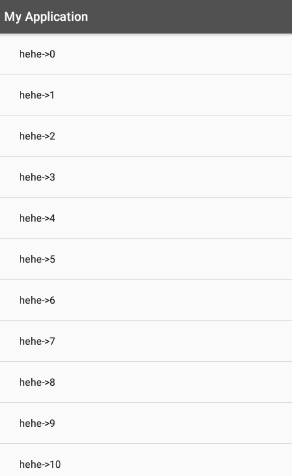本篇文章是我对自定义下拉刷新组件的优化思路。github中有很多优秀的框架为什么还要自己写呢? 学习技术不仅仅在于会用,还要会写。自己动手撸一遍,才会发现其中的乐趣。
本篇还包括下面两个扩展内容
- SwipeRefreshLayout源码解析
- 深入了解自定义属性
好了下面和我一起撸代码吧。
优化
首先我们来看下效果图

相较于上一篇,我们添加了箭头变化的效果,以及文字变化效果。
箭头动画
如果不了解ObjectAnimator,可以参看这篇文章ObjectAnimator详解
为了实现箭头变化效果我们添加下面的代码。 我们的箭头初始化时为0,在下拉过程中,我们让箭头旋转180度。
1 | public void rotateArrow() { |
首先我们要滑动起来才能根据 getScrollerY判断是上拉还是下拉。在下拉的过程中,我们还可以上滑,同理在上拉的过程中,我们可以下滑。因此我们需要根据这些情况,修改目前的状态。
首先定义如下状态:1
2
3
4
5
6
7static final int PULL_IDLE = -1;//无状态
static final int PULL_DOWN_NORMAL = 0;//下拉刷新
static final int PULL_DOWN_RELEASE = 1;//释放刷新
static final int PULL_DOWN_REFRESH = 2;//正在刷新
static final int PULL_UP_NORMAL = 3;//上拉加载更多
static final int PULL_UP_RELEASE = 4;//上拉释放
static final int PULL_UP_REFRESH = 5;//正在加载
根据不同的滑动方式,更新当前状态1
2
3
4
5
6
7
8
9
10
11
12
13
14
15
16
17
18
19
20
21
22
23
24
25
26
27
28
29
30
31
32
33
34
35
36
37
38
39
40
41
42
43
44
45//滑动过程中的变化
private void doScroll(int deltaY) {
if (Math.abs(deltaY) > mTouchSlop) {//超过最小滑动距离
if (deltaY < 0) {//下拉
if (getScrollY() < 0) {//顶部向下拉
if (!pullDownEnable) {
return;
}
isPullDown = true;
if (Math.abs(getScrollY()) <= mPullHeader.getMeasuredHeight() / 2) {
if (Math.abs(getScrollY()) >= mEffectiveScrollY) {
deltaY /= SCROLL_RESISTANCE;//滑动阻力
updateState(PULL_DOWN_RELEASE);
} else {
updateState(PULL_DOWN_NORMAL);
}
}
} else { //底部向下滑动时
if (Math.abs(getScrollY()) < mEffectiveScrollY) {
updateState(PULL_UP_NORMAL);
}
}
} else {//上拉
if (getScrollY() < 0) {//顶部向上滑动
if (Math.abs(getScrollY()) < mEffectiveScrollY) {
updateState(PULL_DOWN_NORMAL);
}
} else {//底部上拉
if (!pullUpEnable) {
return;
}
isPullDown = false;
if (Math.abs(getScrollY()) + Math.abs(deltaY) < mPullFooter.getMeasuredHeight() / 2) {
if (Math.abs(getScrollY()) >= mEffectiveScrollY) {
updateState(PULL_UP_RELEASE);
deltaY /= SCROLL_RESISTANCE;//添加滑动阻力
} else {
updateState(PULL_UP_NORMAL);
}
}
}
}
scrollBy(0, deltaY);
}
}
在解决滑动冲突时,我们用了大量的代码判断内部代码是否为ListView,RecycleView,ScrollView以及是否到达顶部和底部。那么有没有简单的判断的方式呢? SwipeRefreshLayout是Android系统提供我们的原生刷新框架,我们首先来了解下SwipeRefreshLayout的使用,然后在看看SwipeRefreshLayout的源码,我们再进一步修改我们的代码。
SwipeRefreshLayout的使用
SwipeRefreshLayout是Google官方推出的一款下拉刷新组件,位于v4兼容包下,android.support.v4.widget.SwipeRefreshLayout,Support Library 必须19.1以上。
1 | <?xml version="1.0" encoding="utf-8"?> |
主要代码如下,。通过设置OnRefreshListener来监听界面的滑动从而实现刷新。,在刷新监听中处理我们的刷新数据 和 刷新进度的关闭。
其中:
setRefreshing(true),展开刷新动画。
setRefreshing(false),取消刷新动画。
1 | public class RefreshActivity extends AppCompatActivity { |
SwipeRefreshLayout 提供的方法
isRefreshing(): 判断当前的状态是否是刷新状态。
setColorSchemeResources(int… colorResIds):设置下拉进度条的颜色主题,参数为可变参数,并且是资源id,可以设置多种不同的颜色,每转一圈就显示一种颜色。
setOnRefreshListener(SwipeRefreshLayout.OnRefreshListener listener): 设置监听,需要重写onRefresh()方法,顶部下拉时会调用这个方法,在里面实现请求数据的逻辑,设置下拉进度条消失等等。
setProgressBackgroundColorSchemeResource(int colorRes):设置下拉进度条的背景颜色,默认白色。
setRefreshing(boolean refreshing): 设置刷新状态,true表示正在刷新,false表示取消刷新。
SwipeRefreshLayout 源码解析
这篇文章对 SwipeRefreshLayout进行了源码解析
在解析源码的过程中,我们的关注点放在,SwipeRefreshLayout是如何解决滑动冲突的。我们直接锁定在了OnInterceptTouchEvent的源码中
1 | @Override |
来看这几行代码
1 | if (!isEnabled() || mReturningToStart || canChildScrollUp() |
在不可用,以及子类可滑动和正在刷新的过程中,不拦截。
再看这句代码
1 | ensureTarget(); |
一开始使用ensureTarget是什么意思呢?我们看下这个函数
1 | private void ensureTarget() { |
注意到break,获取到我们内容布局中第一个布局就结束循环了。为什么只获取第一个布局呢?再来看看 onMeasure方法
1 | @Override |
注意这几行代码,将我们的mTarget设置为了铺满全屏
1 | //全屏显示 |
综上,我们终于明白了,为什么只获取得一个内容布局了。因为SwipeRefreshLayout只针对获取到的第一个布局,并让他铺满全屏。
回到正题,如何进行拦截呢?再来看看这几行代码
1 | if (!isEnabled() || mReturningToStart || canChildScrollUp() |
关注到 cnChildScrollUp(),并来看下这个函数的代码
1 | /** |
在上一篇我们判断RecycleView的时候,用到了View.canScrollVertically()的方法来判断是否到达顶部和底部,这里直接使用了这个方式。
-1表示向上滑动,1表示向下滑动。由于SwipeRefreshLayout中只使用到下拉刷新,所以这里仅需判断子类是否能够向上滑动即可。
注意到ListView单独列出来了吗?为什么要把ListView单独列出来呢?
在ListViewCompat中我们看到,ListView存在不同版本,在低版本(API<19)时,需要根据firstVisiblePosition否到达顶部,而高版本进行改进后调用canScrollList()。
1 | public static boolean canScrollList(@NonNull ListView listView, int direction) { |
通过上面的解析,我们基本掌握SwipeRefreshLayout的工作原理,那么我们就可以这样修改拦截机制。
优化onInterceptTouchEvent
1 | //滑动过程中的变化 |
为了安全性,使用mTarget时需要判断是否为null。并且设置我们的mTarget为铺面全屏,且只获取第一个mTarget
1 | @Override |
添加头部或底部可选
我们默认情况下是头部和底部可用的,有些时候我们只需要用到下拉刷新或者上拉加载,为了灵活性,我们给自定义刷新组件中添加 布局文件更改的方式以及代码更改的方式。
在布局中选择 头部或底部 是否可用,就需要用到自定义属性文件。那么我们好好了解下属性文件到底是什么?
自定义属性
可以看这篇文章 鸿洋 深入理解自定义属性 以及 自定义属性文件,属性文件
对此方面的知识大概总结一下
自定义属性的使用步骤为:
- 自定义View
- 在values/attrs.xml文件中编写styleable和item 标签元素
- 在布局文件中使用自定义属性
- 在自定义View的构造中 通过TypedArray获取,使用完毕后需要回收recycle。
注意
我们自定义View的时候一定要有构造函数,一定要有参数AttributeSet
1 | public SimpleRefreshLayout(Context context, AttributeSet attrs) { |
为了了解AttributeSet的作用我们举个小例子
在values/attrs.xml中添加下面内容
1
2
3
4<declare-styleable name="test_style">
<attr name="test_name" format="string" />
<attr name="test_color" format="color" />
</declare-styleable>自定义View
1 | public TestView(Context context, @Nullable AttributeSet attrs) { |
- 在布局文件中共添加自定义属性
1 | <com.example.com.myapplication.view.TestView |
打印结果如下
可以从这里了解到,当我们的XML布局创建视图的时候,XML中的属性会通过AttributeSet传递到 构造器中。
LayoutInflater在inflater布局时会通过反射去调用View的(Context context, AttributeSet attrs)构造器。
因此我们自定义View时一定要添加这个构造函数。
1 | public TestView(Context context, @Nullable AttributeSet attrs) {} |
如果不添加 会导致属性资源无法解析,样式不可用。最直观的表现是程序崩了。
一般地,我们使用TypedArray来获取属性值,TypedArray帮我们做了很多事,他相当于一个工具类,通过context.obtainStyledAttributes方法,将AttributeSet的属性加工成对象的属性封装到TypedArray中。
使用方式一
1 | TypedArray typedArray = context.obtainStyledAttributes(attrs, R.styleable.test_style); |
使用方式二
1 | TypedArray typedArray = context.obtainStyledAttributes(attrs, R.styleable.test_style); |
结果
1 | TestView: name 呵呵 : color -16746459 |
为什么要调用recycle呢?
这篇文章讲解了使用recycle的原因
实际上当我们调用ObtainAttributeSet()的方法时,调用了TypeArray的Obtain方法,这个方法是静态的,TypedArray是在array pool中获取到的。下面就是源码
1 | static TypedArray obtain(Resources res, int len) { |
通过这段代码可以得到结论:程序在运行时维护了一个 TypedArray的池,程序调用时,会向该池中请求一个实例,用完之后,调用 recycle() 方法来释放该实例,从而使其可被其他模块复用。
添加可选属性
了解的自定义属性的方式,那么来为我们自定义View添加这部分内容吧
attr文件1
2
3
4<declare-styleable name="SimpleRefreshLayout" >
<attr name="upEnable" format="boolean" />
<attr name="downEnable" format="boolean" />
</declare-styleable>
获取自定义属性1
2
3
4
5
6
7
8
9
10
public SimpleRefreshLayout(Context context, AttributeSet attrs) {
super(context, attrs);
//获取自定义属性
TypedArray typedArray = context.obtainStyledAttributes(attrs, R.styleable.SimpleRefreshLayout
);
pullUpEnable = typedArray.getBoolean(R.styleable.SimpleRefreshLayout_upEnable, true);
pullDownEnable = typedArray.getBoolean(R.styleable.SimpleRefreshLayout_downEnable, true);
typedArray.recycle();
}
动态代码设置
1 | //动态设置下拉刷新是否可用 |
我们来看下设置下拉不可用的效果图
好了,下拉刷新上拉加载方式已经优化的差不多了。github上优秀的SmartRefreshLayout,实现了许多炫酷的效果。后续还会参考优秀项目进行优化修改。
完整代码下载github
参考文章:

